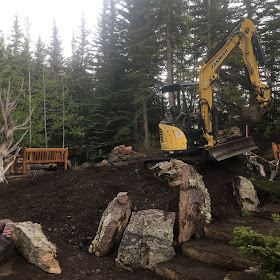Many gardeners are deeply familiar with the small yet rich, dramatic, and beautiful Betty Ford Alpine Garden just off of I-70 in Vail, CO.
It was the first place I saw a crevice garden- a small, low feature, but it still stuck with me.

The stinging Caiophora coronata in their alpine house.
Now, working for their curator Nick Courtens, I got to collaborate in putting in a new Caucasus Mts themed Crevice Garden.
We used around 15 to 17 tons of surface sandstone harvested from far southeast Colorado. We also used a silty soil mix with a little compost and a a lot of chipped gravel to help lock it into the deep crevices we created. The largest stones weighed a bit over a ton, and these were brought in by small front-end loader and mini excavator. A one-ton sandstone boulder is much larger than a granite one.
I tried to challenge myself in a few ways with this- to use forced perspective to make the garden appear even deeper and longer than it is by placing the largest stones closer to the main path. We also integrated steps for a bit of a goat path that connects visitors to a small forested path up slope in back and the nearby Japanese-style contemplation garden with its iconic "floating rock." I loved the "goat paths" in czech rock gardens which allow the able-footed to embed themselves within the garden.
 |
| (Socially-distanced!) Group photo courtesy of Nick |
We built a wide variety of crevice sizes, from paper-thin ones formed by the mere texture of the rock, to 6" (15cm) wide slots. Some are two feet deep. I expect for such deep crevices filled with a true silty soil, there will be wild settling next winter.
Of course, you can't put in a garden without hitting your main irrigation line and having to repair it.
And there must be at least one inconvenient rain.
"The Silk Road" Garden
I myself even brought back Campanula petrophila seed from my time there exactly ten years ago. I identified it using a volume of an old Israeli-translated "The Flora of the USSR" in the Denver Botanic's library.
 |
| Collin pays homage to the Czechs! |
 I expect Nick's newly implemented cold frames will provide the bulk of plants over the years for this garden.
I expect Nick's newly implemented cold frames will provide the bulk of plants over the years for this garden.Until then, treat yourself and visit to the ever-changing Betty Ford Alpine Garden.









